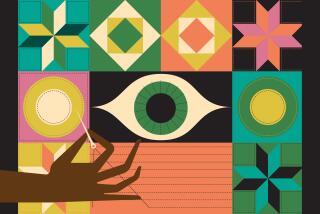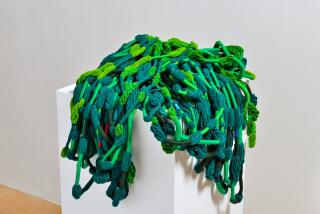AROUND HOME : Notes on Hooked Rugs, Front Doors, Cooing Doves and Restaurant-Supply Stores : Hooked Rugs
- Share via
LONG RELEGATED TO country auctions, swap meets and bric-a-brac shops, hooked rugs are now recognized as one of America’s most appealing artworks. An entirely indigenous craft, hooked rugs were first made by the wives of sailors in the coastal towns of New England.
Using a hook similar to a nautical marlin spike, these women made colorful rugs with whatever pieces of fabric they had on hand. The process was simple: They looped yarn or wool rags cut into strips through a background of linen stretched on a frame. The loops were left unknotted and unsewn, though they were often trimmed to give a softer look. At night by the fireplace, these New England women created many intriguing floral and geometric designs, expressing a degree of creativity that was not apparent elsewhere in their lives. Before long, an important cottage industry grew up around hooked rugs. All over the country, they became immensely popular.
By the middle of the 19th Century, a cheaper and more flexible background material than linen had been discovered: the burlap bags in which grain was delivered. Seams of the bags were opened up, and the burlap fabric was stretched on a hooking frame. Its coarse weave was ideal for accommodating fabric strips, and the almost universal use of these sacks explains the standard measurement of most hooked rugs (46 inches by 40 inches). In the 1870s, peddlers began to sell hooked-rug patterns, and soon burlap sacking was available with pre-printed designs. Round, oval or extra-large rugs are relatively uncommon because of these standard dimensions. And because of the popularity of patterns, the designs on hooked rugs are often surprisingly similar even though the rugs may have been made in different parts of the country.
Old hooked rugs are more valuable than new ones, of course, and original designs are more prized than those made from patterns. Hearts, sailing ships and portraits of cats are particularly popular with collectors today, as are hooked-rug prices--rugs selling for more than $1,500 are unusual. Colorful, primitive and charming, hooked rugs provide a welcome contrast to the hard edges of today’s minimalist design.
Antique hooked rugs may be found at the Quilt Gallery, Santa Monica; Margaret Cavigga Quilt Collection, Los Angeles; Millstein’s General Store, West Los Angeles; Main Street USA, Venice; Wild Goose Chase, Santa Ana; the Blue Quail, San Juan Capistrano, and Roberta Gauthey Antiques, Laguna Beach.
DR


